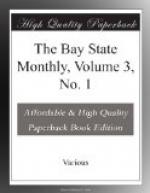[Footnote 7: Mss. letter of Henry T. Drowne, Esq., of New York.]
[Footnote 8: Samuel G. Drake’s “History of Boston.”]
[Footnote 9: History of “Bristol and Bremen.”]
[Footnote 10: Drake in “Old Landmarks,” says: “the grasshopper was long thought to be the crest of the Faneuils.”]
[Footnote 11: Boston Daily Advertiser, December 3, 1852.]
[Footnote 12: Historical and Genealogical Register, vol. XXVII, p. 422.]
* * * * *
THE WEDDING IN YE DAYS LANG SYNE.
By Rev. Anson Titus.
The story of courtship and marriage is ever fascinating. It is new and fresh to the hearts of the youthful and aged. A few words upon the marriage day in the early New England will not be without interest. September 9, 1639, the General Court of Massachusetts Bay Colony passed a law ordering intentions of marriage to be published fourteen days at the public lecture, or in towns where there was no lecture the “intention” was to be posted “vpon some poast standinge in publique viewe.” On this same day it was ordered that the clerks of the several towns record all marriages, births and deaths. This was a wise provision. It at once taught the people of the beginning and of the designed stability of the new-founded government.
The course of true love did not run smooth in these early days any more than to-day. Parents were desirous of having sons and daughters intermarry with families of like social standing and respectability. But the youth and maid often desired to exercise their own freedom and choice. On May 7, 1651, the General Court ordered a fine and punishment against those who “seeke to draw away y’e affections of yong maydens.” In the time of Louis XV, of France, the following decree was made: “Whoever by means of red or white paint, perfumes, essences, artificial teeth, false hair, cotton, wool, iron corsets, hoops, shoes, with high heels, or false tips, shall seek to entice into the bonds of marriage any male subject of his majesty, shall be prosecuted for witchcraft, and declared incapable of matrimony.” The fathers of New England may have made foolish laws, but this one in France at a later time goes beyond them. The seductive charms of the sexes they deemed could not be trusted. Wonderment often comes to us of the thoughts and manners of the sage law-makers when their youthful hearts were reaching out after another’s love.
The marriage day was celebrated with decorum. The entire community were conversant of the proposed marriage, for the same had been read in meeting and posted in “publique viewe.” The earliest lawmakers of the Colony were pillars in the church, and though they did not regard marriage an ordinance over which the church had chief to say, yet they desired an attending solemnity. In 1651 it was ordered that “there shall be no dancinge vpon such occasions,” meaning the festivities, which usually followed the marriage, at the “ordinary” or village inn.




